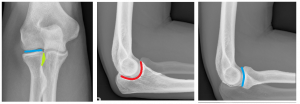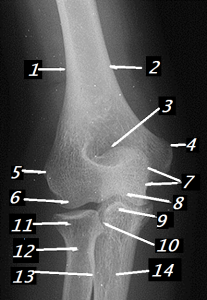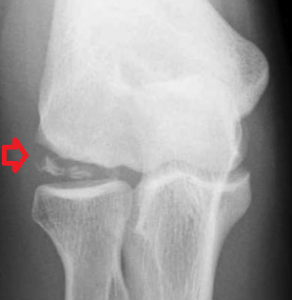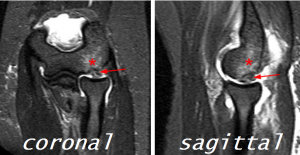13 Osteochondral Injuries of the Elbow
Throwing places extremely high stresses on the elbow and thus overuse can damage the articular (cartilage) surfaces. Two characteristic areas are affected in throwing athletes: the olecranon process of the ulna and the distal humerus where it articulates with the radius, namely, the capitellum. In the olecranon, valgus forces erode the surface cartilage, and stimulate the production of bone spurs. In the distal humerus, more often the inciting pathology is ischemia of the subchondral bone causing osteonecrosis, a condition known as osteochondritis dissecans. Most patients with chondral injuries to the elbow recover with rest, but surgery may be needed if there are loose bodies or unstable cartilage flaps.
Structure and Function
The elbow joint consists of the distal end of the humerus and the proximal aspects of the radius and ulna; and has three articulations: the ulnohumeral articulation, the radiohumeral articulation (also known as the radiocapitellar joint) and the proximal radioulnar joint (See Figures 1, 2 and 3).



The ulnohumeral joint consists of the olecranon and the coronoid process of the ulna articulating with the humerus at the trochlea. The primary function/motion of the ulnohumeral joint is flexion and extension of the elbow.
A so-called valgus extension overload injury can result from excessive forces in the elbow during the throwing motion and is characterized by the breakdown of cartilage on the olecranon.
The radiocapitellar joint is the articulation of the proximal radius (radial head) with the distal end of the humerus (capitellum) and functions to pronate and supinate the lower arm. The radiocapitellar joint is supplied by the radial recurrent and interosseous recurrent arteries. This blood supply can be too-easily disrupted by repetitive microtrauma leading to ischemia and osteonecrosis. The constellation of necrosis and disruption of the joint surface is called osteochondritis dissecans. Osteochondrosis of the capitellum in patients under ten years of age is called Panner’s disease. Because the prognosis for osteochondrosis of the capitellum is so much better when the patients are very young, Panner’s disease is truly a distinct entity and worthy of its own name.
The proximal radioulnar joint is the articulation between the radial head and the radial notch (lesser sigmoid notch) of the ulna. The radioulnar joint allows for rotation of the radial head. This joint is rarely the cause of elbow symptoms in throwers.
Clinical Presentation
Patients often present to clinicians with an insidious onset of elbow pain that gradually worsens with activity. Patients typically have pain while bending or straightening the elbow.
Mechanical symptoms may be present (popping/locking) and may indicate more advanced disease (loose body formation). The subjective complaint of stiffness is commonly reported.
Physical examination typically demonstrates a decreased range of motion when compared to the unaffected, contralateral extremity.
There may be a palpable effusion, crepitus, and tenderness to palpation. The location of tenderness may be sufficiently specific to point to the diagnosis. Pain at the radial head points to a diagnosis of osteochondritis dissecans of the capitellum. Pain and tenderness at the posteromedial tip of the olecranon will suggest valgus extension overload.
When palpating the soft tissues, the flexor-pronator muscles and the MCL are the most important structures to be examined. Pain among flexor-pronator masses indicates potential medial epicondylitis from an overload of stress and subtle instability of the elbow. Generally, medial epicondylitis caused by throwing strongly suggests MCL ligament damage. Pain or instability with valgus stress suggests a sprain of the ulnar collateral ligament.
Objective Evidence
All patients with persistent elbow pain should obtain plain radiographs of the elbow in full extension, and at 90 degrees of flexion (Figure 4).

Magnetic resonance imaging is a valuable diagnostic tool in evaluating the articular surface as well as the ligaments nearby (Figure 5). These images should be scrutinized to determine if there is cartilage damage, bony collapse or loose fragments.

Epidemiology
Elbow pain is commonly seen in overhead throwing and non-throwing athletes, such as baseball pitchers, quarterbacks, volleyball and tennis players and gymnasts. The incidence of definitively diagnosed cartilage lesions (arthrosis) is low, but that may represent under-diagnosis.
The elbow is the second most common location for osteochondritis dissecans. (Note that the elbow is a distant second: a vast majority of osteochondritis dissecans lesions are found in the medial femoral condyle of the knee.)
Panner’s disease is more commonly seen in males, however that may be a function of social forces – namely that males are more likely to participate in throwing sports.
Differential Diagnosis
Throwing, especially frequent throwing at high velocity, can exceed the capacity of the human body, and thus elbow pain is not uncommon in those who throw frequently at high velocity.
The differential diagnosis of elbow pain in throwing athletes includes tendonitis of the flexor/pronator tendons, sprains of the ulnar collateral ligament, irritation of the ulnar nerve, as well as articular surface pathologies described here. Stress fractures around growth plates may also produce the presenting symptoms.
Red Flags
There are no noteworthy red flag conditions.
Treatment Options and Outcomes
The first-line treatment of elbow pain in throwing athletes is rest. A short course of immobilization may help reinforce the recommendation for rest. After approximately 3-6 weeks of rest, patients can gradually return to normal activities over the next 1-2 months. Non-steroidal anti-inflammatory medication (NSAID) can be administered for pain management.
Operative treatment is indicated for skeletally mature patients with symptomatic, unstable lesions or lesions that have failed to heal with the use of non-operative management.
Arthroscopic micro-fracture or drilling of the capitellum with or without loose body removal has been used as a surgical treatment of osteochondritis dissecans of the elbow. In this procedure, the surgeon penetrates the subchondral bone to allow blood to reach the affected area. The bleeding stimulates the growth of fibrocartilage to fill the lesion. Cartilage transfer procedures (popularly known by its acronym, OATS, standing for “osteochondral autograft transfer system”) are another option. In this procedure, plugs of cartilage and bone are taken from a healthy area and are implanted to fill the lesion.
Fixation of the lesion is another surgical option which is indicated for larger lesions that are partially displaced or hinged.
Arthroscopic debridement and loose body excision is utilized for patients with unstable lesions who have catching or locking symptoms of the elbow.
Panner’s disease is typically a self-limited condition that resolves once the epiphysis revascularizes and heals.
Outcomes are usually good in patients as long as there are no loose bodies; the presence of such bodies suggests more advanced disease. Recurrence of loose body formation and progression to arthritis is not uncommon.
Potential complications of treatment include elbow stiffness (especially from prolonged immobilization) and iatrogenic injury at surgery. Injury to the superficial radial, ulnar, posterior interosseous, medial antebrachial cutaneous, and anterior interosseous nerves can occur even with excellent technique. Infection is rare but possible.
Risk Factors and Prevention
The primary risk factor for developing osteochondral lesions in the elbow is overuse, especially with activities that place significant compressive forces across the elbow. Too much throwing is harmful; pitch count limits should be observed especially in young players. Learning proper mechanics may also help reduce injury. It is critical that athletes do not continue to throw in the presence of symptoms.
Miscellany
The term “little leaguer’s elbow” refers to any medial elbow injury in young throwing athletes, and may include medial epicondyle stress fractures, ulnar collateral ligament sprains or injuries to the flexor-pronator muscles.
Key Terms
Osteochondritis dissecans, Panner’s disease, osteonecrosis, loose bodies, ulnohumeral articulation, radiocapitellar joint, proximal radioulnar joint, trochlea, capitellum
